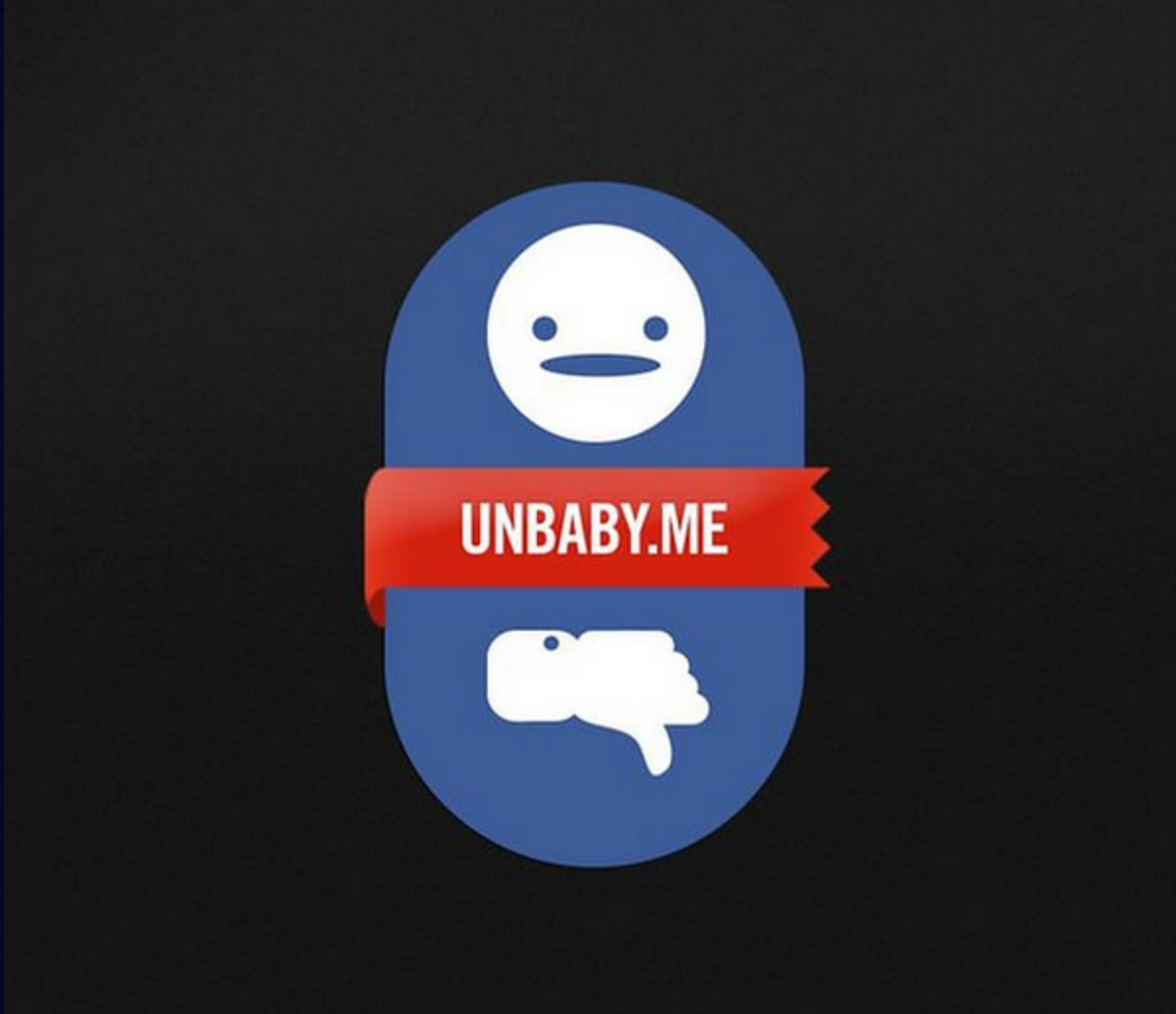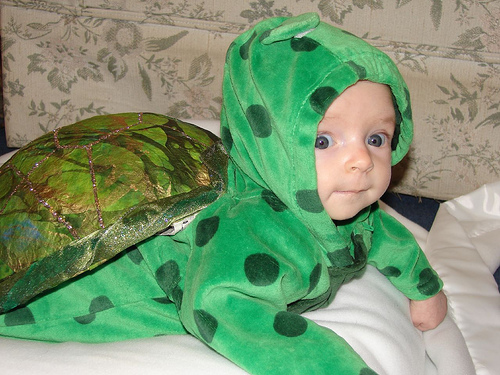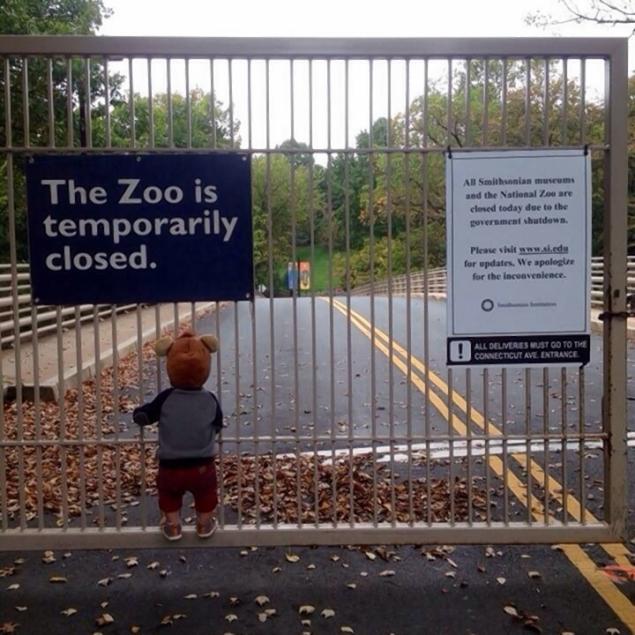Cats, Babies, and Other Hurtable Creatures

In 2012, a developer named Chris Baker released a Chrome extension called “Unbaby.me,” which used simple keyword detection to replace images of babies in Facebook news feeds with, in Baker’s words, “better stuff, like cats.” Although users could change the replacement images to something else, cats were the default. The plugin received widespread attention, including features in The New York Times, National Public Radio, the Baltimore Sun, Jezebel, and Vice. In a much-publicized study of new mothers’ uses of social media for Microsoft Research, Meredith Ringel Morris cited Unbaby.me as an index of the widespread perception that Facebook news feeds are absolutely chock full of baby pictures. The browser extension was retired after only a few years, but its temporary viral uptake suggests two things: that pictures of babies are often perceived as ubiquitous in online social engagements, and that, if you don’t want to see pictures of babies, the logical thing with which to replace them is pictures of cats.

I am interested in the hypercuteness of representations that combine children and animals—children with animals, children dressed as animals, and animals in “Halloween costumes,” i.e. animals dressed as children dressed as animals. I wish to suggest that such images’ popularity and circulatability on the Internet reveal something important about the role that the figure of the child plays in the internet’s affective currents and currencies. The internet embodies, and often closely facilitates, the “new economy” of precarity, gig labor, and spec work, where, as Jodi Dean has pointed out, many work and a few get paid. And despite the flow of venture capital into internet-based startups, the internet is also place where it is notoriously difficult to make an actual profit. Consequently, alternative currencies flourish on the Internet, from website hit counts and Twitter followers to “Klout,” academic “altmetrics,” and of course literalized alternative currencies like Bitcoin. The fact that, on the internet, it’s relatively easy to earn any kind of currency but the kind that pays your rent sparks both utopian and dystopian discourses, imagining the internet alternately as a utopian “gift economy” freed from profit motives, as in the open-source software movement, and as a dystopian realm of exploitation in which much unpaid labor must be expended even to gain the chance to be paid.
Abigail De Kosnik has detailed the ways in which fan labor and “labors of love” produce value for corporations and, in which producers of this value see themselves as amply rewarded in satisfaction. Similarly, as Tiziana Terranova argues, participants on social media perform “free labor” that produces those platforms’ value. For good or ill—probably, from a labor perspective, for ill—affective currency is real and powerful on the internet, and drives the elusive and rare production of actual financial profit, usually in the highly mediated form of advertising revenue. As current discourses on “clickbait,” “upworthiness,” or the “internet outrage machine” already acknowledge, understanding affective currency is important for understanding profit. The internet is, at some level, a networked instrument for converting distributed affect—even relatively low affect—into concentrated profit. The conversion happens at the level of “engagement”: interaction, or “clicks.”
And that’s where the cute babies—or the babies that you hate and want to replace with cats—come in. Morris’s own research, which suggests that new mothers actually post disproportionately less, nonetheless notes the correlation between baby pictures and social interaction: even if new mothers aren’t actually posting very many baby pictures, those status updates that did mention the baby received “attention scores” that were, on average, twice as high as those updates that did not mention the baby. Since the Facebook News Feed algorithm seems to privilege “engagement,” baby pictures are shown to more people and placed higher on people’s news feeds, creating the perception that people are constantly posting about babies. Often feminized compulsory affective performances, such as “liking” a friend’s baby picture or commenting about how cute it is, turn into engagement metrics, which turn into advertising dollars.
The complement to this kind of “cute” affective currency is the internet’s “bad” affects, which, as Lisa Nakamura argues, are not ancillary but rather central to internet cultures. Nakamura cites a telling 2013 headline from the humor newpaper The Onion, “YouTube Reaches a Trillion Racist Comments.” It’s a joke, but not a joke: whereas racism is treated as a “glitch” in internet culture, like technical glitches, it is a normative experience. Thus the alleged contrast between the cute or fun cat video and the hateful comments that will inevitably accumulate below it is only an ideological alibi for the closeness with which they are paired. Digital affects are often described as belonging to a quantitative scale of opposing extremes—either the relentless compulsory positivity of networks like Facebook, Pinterest, and LinkedIn, or the pathological affects of discussion boards like 4Chan and Reddit, often described as “cesspools” and “toxic.” This binary map of digital affects is mirrored in the work of “sentiment analysis” in natural language processing, which canonically aims to index “positive” and “negative” sentiment, often to maximize clicks and profit. Yet the aesthetics of affective currency interarticulate pleasure and aggression in ways that frustrate the distinction between the “upworthy” and “toxic” internets.

For example, during the US government shutdown of 2013, this image of a sad child dressed as an animal circulated virally. “This Adorably Sad Image Is Now The Official Photo Of The U.S. Government Shutdown,” read a headline at Buzzfeed. Its iconography is presented as self-explanatory, summing up the “sadness” of the government shutdown. The image of the child plastered to these bars—as if trying to get in, but also as if playing on the bars as a monkey might—seems to suggest that the child is longing to join his animal comrades in captivity, thwarted by adult political maneuvers from an already abject aim. In other words, it’s a scene of multiple abjections—of disempowerment, of disappointment, of ostensible self-identification with a caged animal; in short, as Buzzfeed puts it, “adorably sad.” These are all, of course, projections, since there’s nothing about the fact that a child’s parents have decided to dress him up in an animal costume that would logically suggest that that child particularly loves animals, or would be particularly crushed by the zoo’s closure. The projection required to extract pathos from the decontextualized photo is to some degree worn on its photo’s faceless face. And indeed, in the days after the photo went viral, multiple debunkings were published, reporting information from the child’s parents that the child—still identified as “the sad kid”—knew nothing of the shutdown and was simply playing on a gate. But of course, such debunkings were also occasions for drawing attention to the image yet again. What made this image so circulatable? What, in other words, gave it the kind of affective currency that generates clicks, which in turn generate profits?
Lisa Nakamura’s recent work on the practice of “scambaiting” sheds some light on the affective currency of images. “Scambaiters,” usually western white men, aim at revenge on internet users—mostly African, and also mostly men—who attempt wire transfer scams by demanding proof of good faith in the form of humiliating photographs, which are then circulated on scambaiter message boards like 419eater.com for status. In one of the images Nakamura cites, which I won’t reproduce here, two men wearing bras and skirts face each other, carrying a third, prone man slung between them by his wrists and ankles. The upright men are balancing something large and white on each of their heads; each of them has a large cucumber sticking out of his mouth. The man being carried is dressed in something that looks like a giant toaster strudel. Nakamura documents this particular image as appearing “across at least 13 image-sharing websites.”

Nakamura points out the colonialist iconography in scambaiting images, which, on one site, are archived in a section literally titled “The Trophy Room.” These abject images often document painful marking of the black male body, such as tattoos of humiliating sayings. “I Give BJ’s,” reads the tattoo in one image. Eliciting these images, as Nakamura argues, confers “digital visual capital” on posters to scambaiting fora. I wish to push this idea of “digital visual capital” a little further, especially in the context of scambaiting, which presents itself as a kind of vigilante justice against criminals. In fact, 419eater.com includes some very defensive text arguing that even though scambaiters do largely target Africans, they are only doing it to punish theft. Even at low resolution, it is easy to see how see how much bold text, caps lock, and even text in red is used to justify the “Trophy Room,” indicating the aggression that is elsewhere at least notionally sublimated as laughter, and defensively acknowledging the violence of these images.
As we have already seen, scambaiters’ defenses of their practices backhandedly acknowledge the images’ violence. Yet the scambaiters who elicit them, in Nakamura’s words, “operate under the sign of fun and amusement,” and although the images are produced through a racialized dynamic of global economic power relations, they circulate because, decontextualized, they are easily assimilable to the multiple choice emotions of lol and wtf. In fact, when I downloaded a copy of one of these viral pictures in the course of writing this piece, the file name on that copy was “lol_wtf_186.jpg,” as if the emotions that made it circulate were also a complete description of its content. Whereas the conditions of its production are a set of complex global power dynamics underwritten by histories of violence and exploitation, the conditions of its circulation are precisely a disavowal of any such history, replaced by an affect of non-knowledge: “wtf?”
That affect of agnosis—“wtf”—supplies a warrant for circulation, even as it is also the default response to circulation. In fact, in one of the debunkings of the “sad child at the zoo” image, the Washington Post columnist Anne Midgette—who is a close friend of that child’s parents—recounts her own moment of agnosis; not recognizing the child, she nearly shares the link on Facebook. The column quickly becomes a moralizing comment on virality and the way that a decontextualized, pseudoprivate photo becomes, “fair game for commenters around the nation.” Midgette closes by lamenting a “lost innocence”— “our innocence as parents, learning first-hand what it feels like to have an intimate moment, an inside joke, exposed to the corrosive air of public opinion.” Midgette rehearses the classic opposition between “cute” photo and “toxic,” or in this case, “corrosive” comments. Her scene of lost parental innocence follows on a scene of innocence—that is, ignorance of context—that was precisely a near occasion for sharing the photo. Insofar as not knowing conditions of production is itself a position of innocence, “wtf,” the affect of not knowing, permits and indeed promotes sharing.
This interplay of violence and innocence makes not only “wtf” but also cuteness an occasion for the kind of sharing that realizes the digital image as affective currency. Sianne Ngai has brilliantly theorized the ways that “cuteness,” far from generating uniformly positive affects, invokes a dialectic of vulnerability and violence between the cute object and its beholder, placing cuteness on a continuum with its “toxic” and ostensibly opposite digital affect. “In cuteness,” Ngai argues, “it is crucial that the object ha[ve] some sort of imposed-on mien—that is, that it bears the look of an object unusually responsive to and thus easily shaped or deformed by the subject’s feeling or attitude toward it,” to the extent that “the cute object's exaggerated passivity seems likely to excite the consumer's sadism or desire for mastery as much as her desire to protect and cuddle.” I point this out not only to insist on the circuit of aggression driving online affective currency, but also to suggest that the “shareability” that produces value on the internet responds to the already-commodified status of the cute object. For the cute object’s plasticity or responsiveness in relation to the observer suggests, as Ngai argues, that “Cuteness might...be said to epitomize the process of affective ‘objectification’ by which all aesthetic judgments are formed,” and should indeed be understood as an aesthetic of the commodity. Kathryn Bond Stockton has shown that, especially from the early twentieth century, childhood’s alleged “innocence” is imagined in part as an innocence of the market. Ngai’s theorization shows how cuteness relies on a “pastoral fantasy” of innocence of the market, and is therefore actualized by a return to the market:
By returning us to a simpler, sensuous world of domestic use and consumption, populated exclusively by children and their intimate guardians, cuteness is the pastoral fantasy that somehow, the commodity's qualitative side as use-value, or as a product of concrete, phenomenological labor, can be extracted and therefore “rescued.” Yet this romantic fantasy requires force, a willfulness of imagination arguably reflected in the physical distortions of the cute form...The desire to fondle and squeeze the object that cuteness...elicits—even to the point of crushing or damaging that object—might thus be read as an effort to “grasp” the commodity as a product of concrete human labor.
Cuteness, like wtf, is thus also about almost violently disavowing knowledge of the economy in which the “free labor” of the internet participates. The internet runs on cats, babies, and other hurtable creatures, and the “minor” aesthetics that make an image circulatable acquire their meaning and affective charge substantially through the ways in which beliefs about childhood make innocence available. In the place where it’s easy to accrue any kind of currency but the kind that pays your rent, the aesthetics of what Ngai calls the “charismatically ‘irrelevant’”—whose performance of externality to the market has to be reinforced by a viewer’s willful or even aggressive projection—carries the most affective currency, the currency that drives clicks, and brings ad revenue for somebody, but not for you, the internet user who is clicking “share.”
In his famous “fuck the child” litany at the beginning of No Future, Lee Edelman cites the “poor, innocent kid on the Net” as a paradigmatic potential victim whom reproductive futurism seeks to protect. Both the child and the threats are tellingly ambiguous: the child could be a child using the internet whose innocence is threatened either by exposure to “adult content” or by predators; the child could also be, as in Anne Midgette’s Washington Post column, a cute image that gets symbolically manhandled by a “corrosive” digital public. And certainly, as Midgette’s spectacularly formulaic column suggests, that trope of child victimization exists, and exists in particular to shore up the moral rights of the private liberal family. But what both “fuck the child” and “save the child” miss is the way that sad children and the pastoral fantasy of innocence sponsored by their image underwrite the very circulation that supposedly threatens them.
Bibliography
Baker, Chris. “Unbaby.me.” Chris Baker. Accessed September 30, 2015.
Considine, Austin. “Unbaby.me Keeps Baby Pictures Off Facebook.” The New York Times, August 8, 2012.
Cornish, Audie. “Photos On Facebook: Can There Be Too Many Babies (Or Animals)?” All Things Considered. National Public Radio, August 20, 2012.
D’Arcy, Janine. “Unbaby.me Is Funny, the Hostility to Families? Not so Much.” Washington Post. August 7, 2012.
Dean, Jodi. “Whatever Blogging.” In Digital Labor: The Internet as Playground and Factory, edited by Trebor Scholz, 127–46. New York: Routledge, 2013.
De Kosnik, Abigail. “Fandom as Free Labor.” In Digital Labor: The Internet as Playground and Factory, edited by
Trebor Scholz. New York: Routledge, 2013.
Edelman, Lee. No Future: Queer Theory and the Death Drive. Durham: Duke University Press, 2004.
Golgowski, Nina. “Tired of Seeing Photos of Your Friends’ Babies? Hilarious App Blocks out ‘Cutesy’ Pictures from Social Network Sites.” The Daily Mail, August 5, 2012.
Hayek, F. A. “The Use of Knowledge in Society.” The American Economic Review 35, no. 4 (September 1, 1945): 519–30.
Johnson, Benny. “This Adorably Sad Image Is Now The Official Photo Of The U.S. Government Shutdown.” BuzzFeed, October 10, 2013.
Kelber, Sarah Kickler. “Replace Kids in Your Newsfeed with Cats Thanks to Unbaby.me.” Baltimore Sun. August 2, 2012.
Lawlor, Ryan. “Unbaby.me? Yes, Please.” TechCrunch, August 4, 2012.
Midgette, Anne. “I Know the Sad Kid at the Zoo.” The Washington Post, October 11, 2013.
Moore, Tracy. “Guess What? I Hate Your Sushi Pics Almost As Much As You Hate My Baby Photos.” Jezebel, August 13, 2012.
Morris, Meredith Ringel. “Social Networking Site Use by Mothers of Young Children.” In Proceedings of CSCW. Baltimore, MD: ACM, 2014.
Nakamura, Lisa. “Glitch Racism: Networks as Actors within Vernacular Internet Theory.” Culture Digitally, December 10, 2013.
———. “‘I WILL DO EVERYthing That Am Asked’: Scambaiting, Digital Show-Space, and the Racial Violence of Social Media.” Journal of Visual Culture 13, no. 3 (December 1, 2014): 257–74. doi:10.1177/1470412914546845.
Ngai, Sianne. Our Aesthetic Categories: Zany, Cute, Interesting. Cambridge, Mass: Harvard University Press, 2012.
Parker, Graham. Fair Use: Notes from Spam. Santa Monica: Ram, 2009.
Phillips, Tom. “The Sad Picture Of A Child At A Shut-Down Zoo Is Not Actually A Sad Picture.” BuzzFeed, October 14, 2013.
Ryan, Erin Gloria. “Finally, A Way to Turn Facebook Baby Pictures into Adorable Cats.” Jezebel. Accessed October 2, 2015.
Stockton, Kathryn Bond. The Queer Child, or Growing Sideways in the Twentieth Century. Durham: Duke University Press, 2009.
Swift, Bryan. “Thank God for Unbaby.me.” VICE (United States). Accessed October 2, 2015.
Terranova, Tiziana. “Free Labor: Producing Culture for the Digital Economy.” Social Text 18, no. 2 (2000): 33–58.